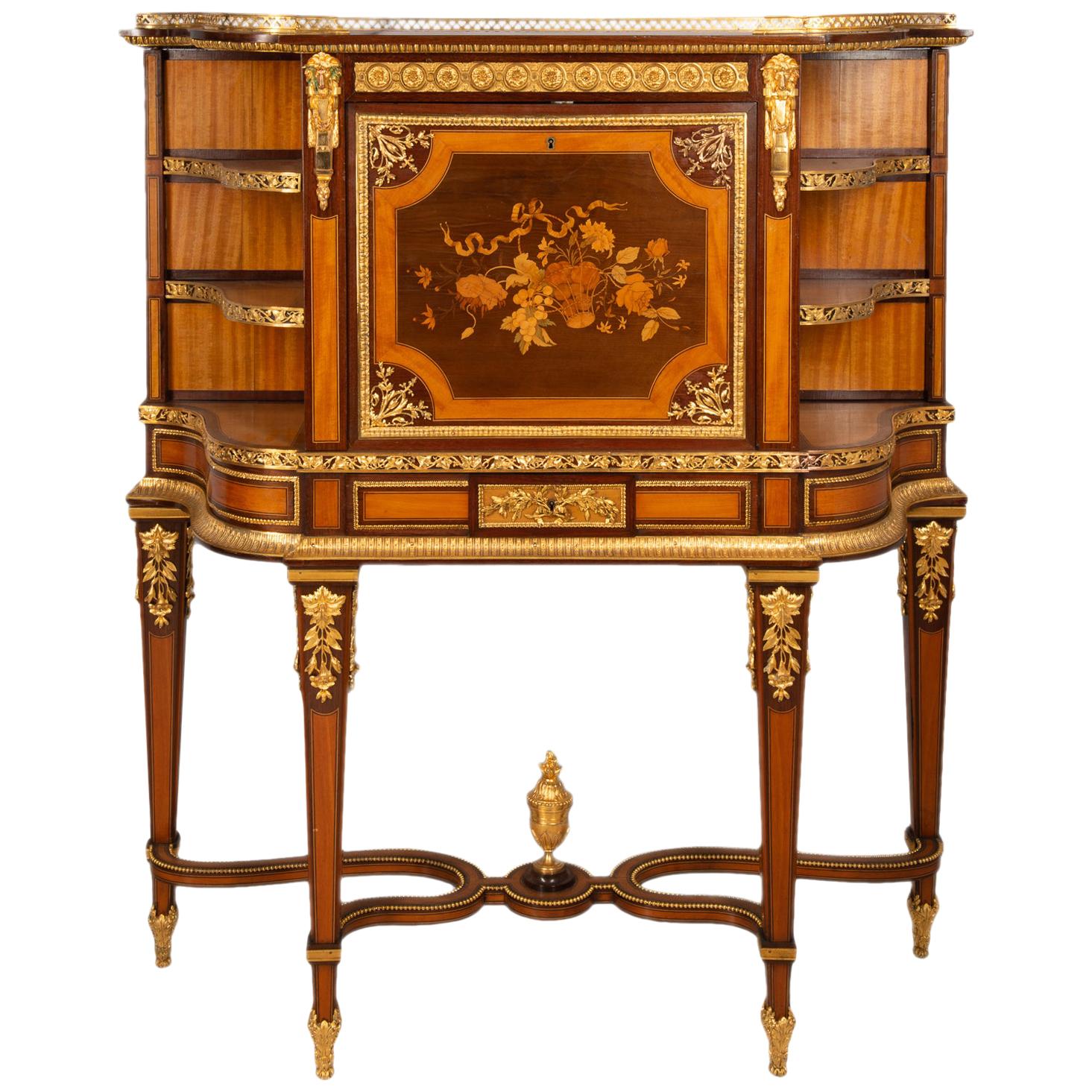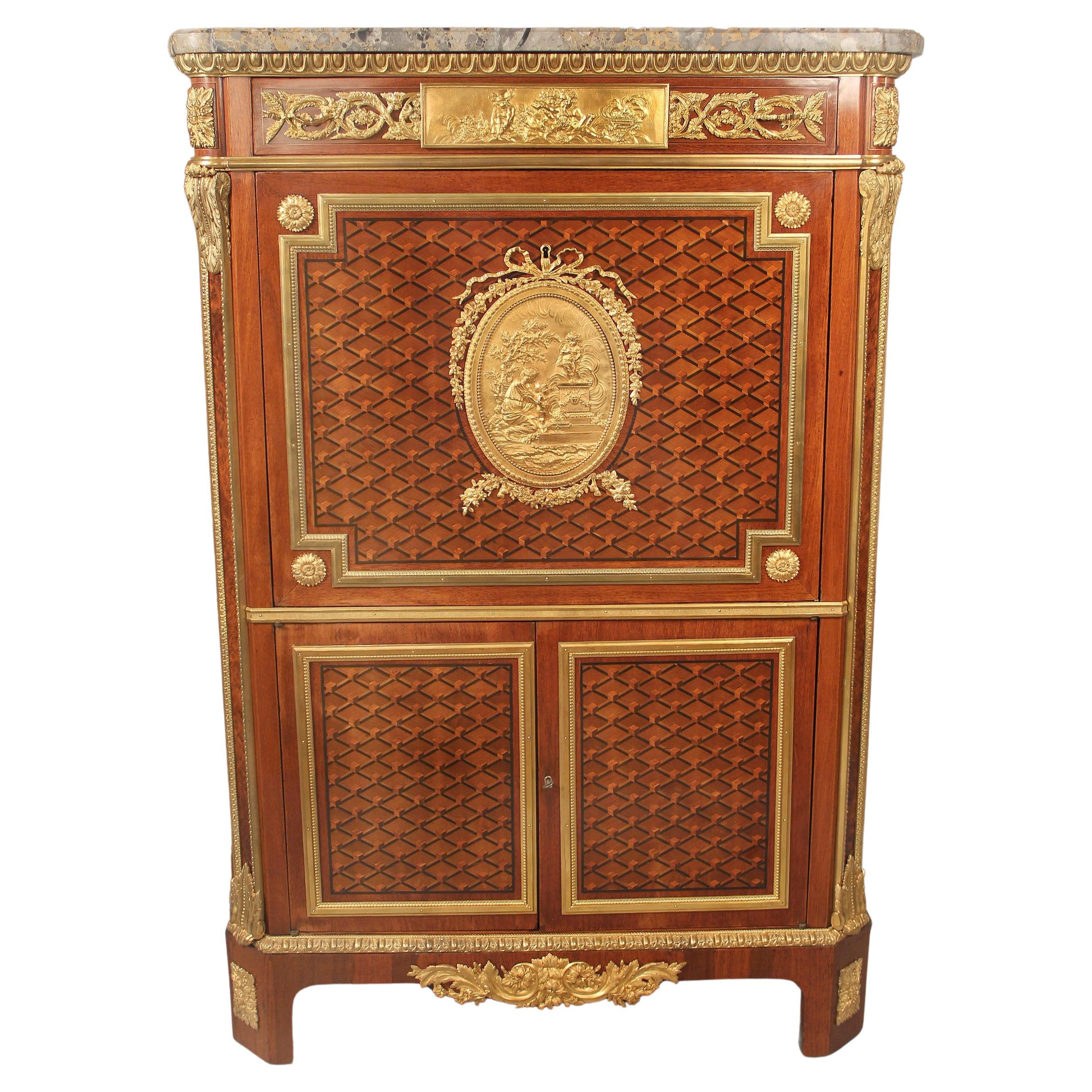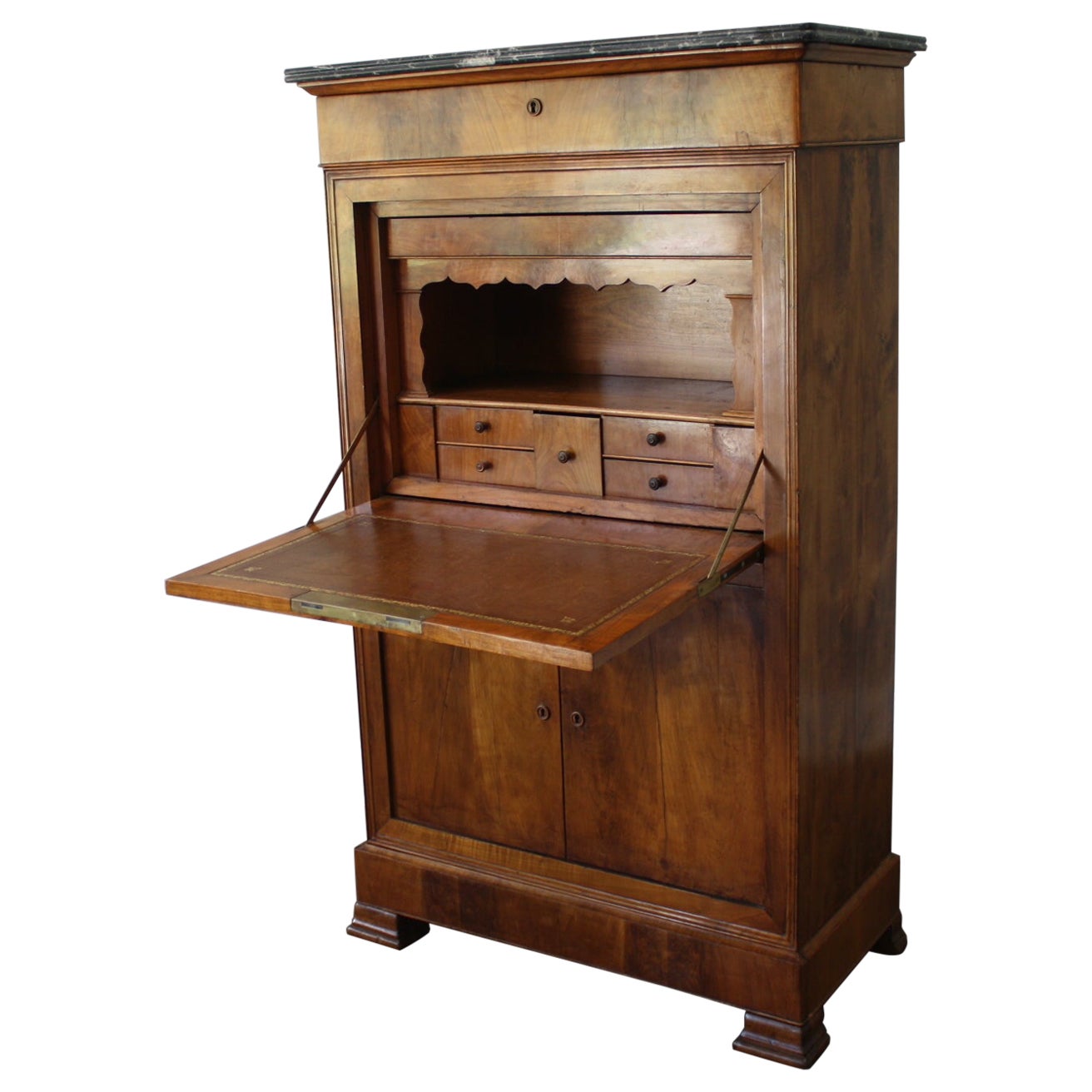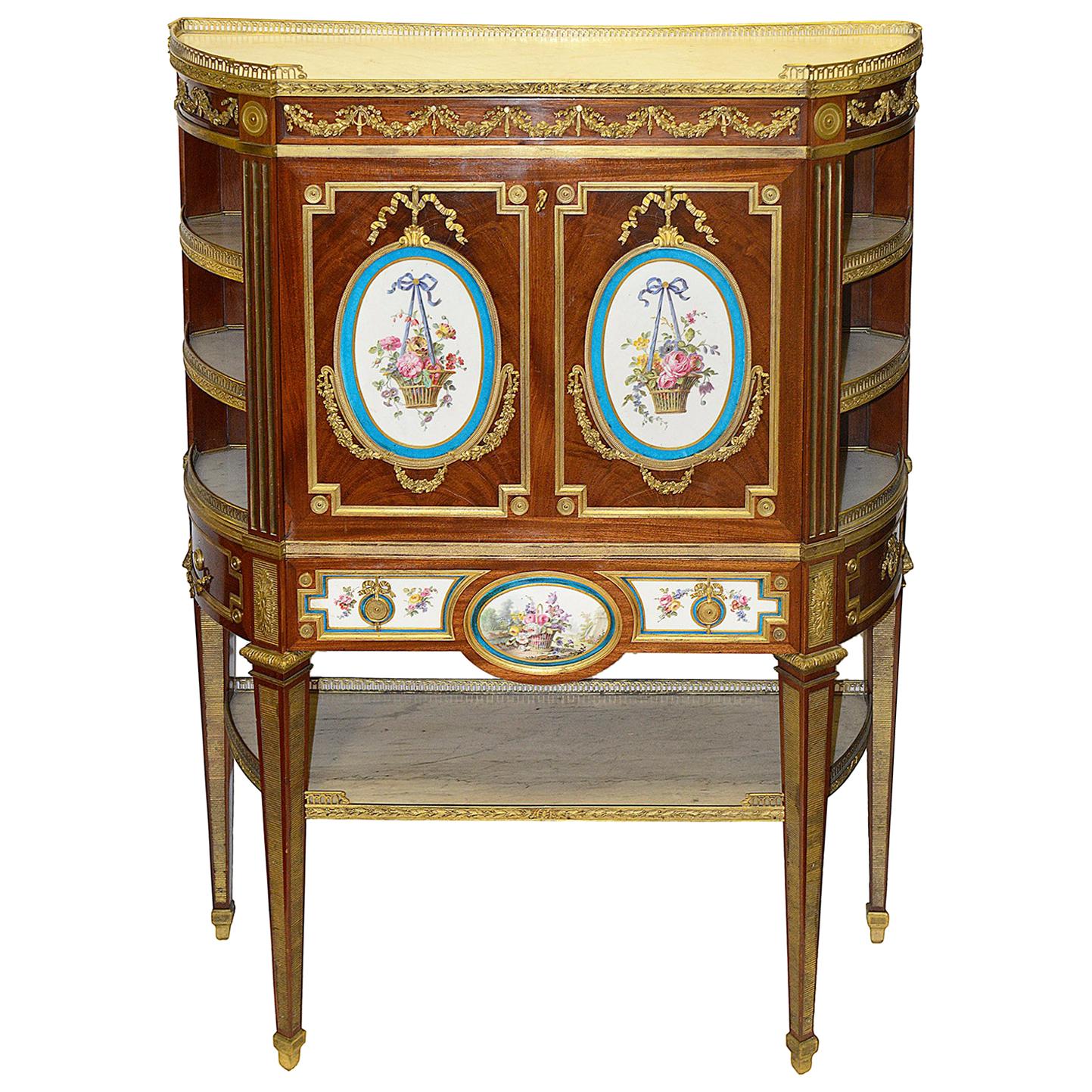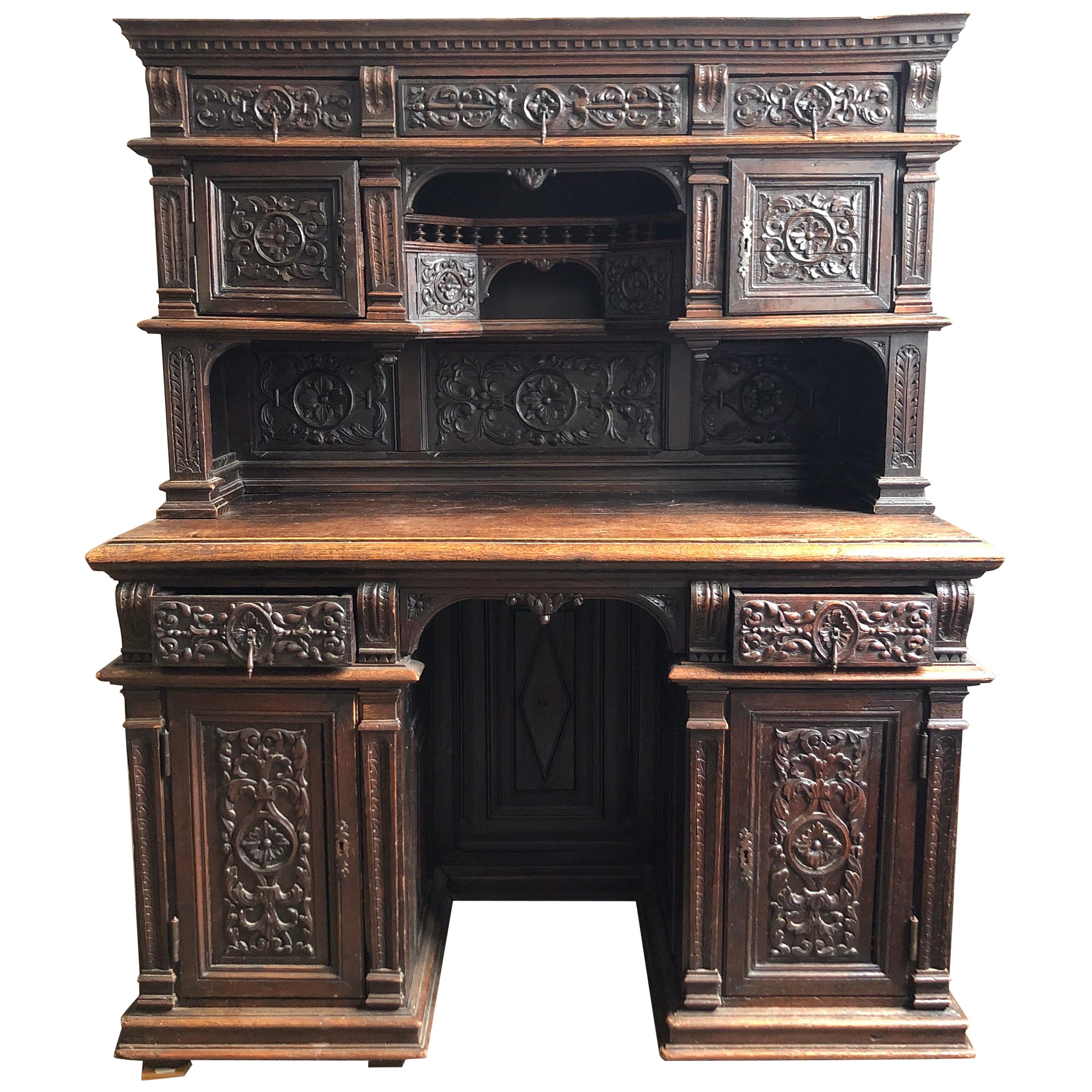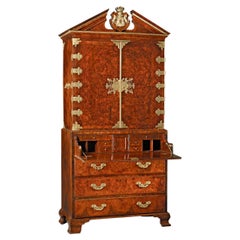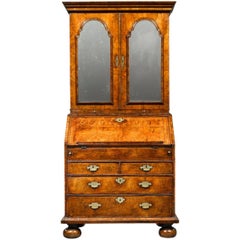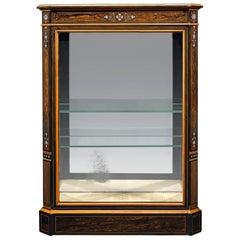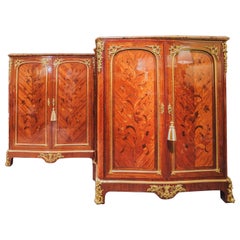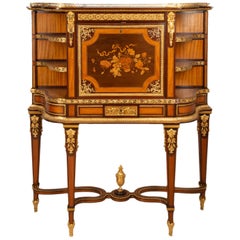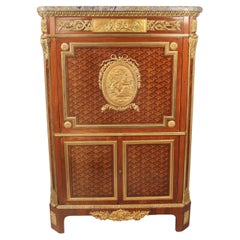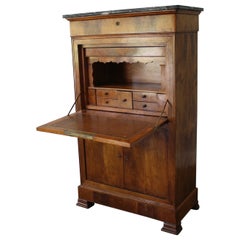Items Similar to 19th Century French Secrétaire by Durand
Want more images or videos?
Request additional images or videos from the seller
1 of 5
19th Century French Secrétaire by Durand
About the Item
Superior craftsmanship and intricate marquetry characterize this rare secrétaire by Gervais-Maximilien-Eugène Durand, one of the most popular French ébénistes of the 19th century. This is an exceptional example of his work, bringing together beautiful materials and a practical, yet elegant design. The compact Louis XV-inspired form features two visible shelves, as well as two others cleverly hidden by a false front at the base. Beautifully embellished with Durand's distinctive Rococo-style ormolu mounts, the secrétaire rests on four curved feet enveloped by ornamented bronze.
Celebrated as one of the greatest ébénistes of luxury furniture at the turn of the century, Durand was a master at creating original designs inspired by the Louis XV and Rococo styles. He established the firm of Maison Durand in 1870, and he soon thereafter received international recognition when the maison triumphed at the 1889 Paris Exposition Universelle. Today, high-quality, signed examples such as this are becoming increasingly scarce finds.
Stamped "G. Durand"
circa 1880
Measures: 46 1/8" high x 24" wide x 11" deep.
- Creator:Gervais Durand (Maker)
- Dimensions:Height: 46.13 in (117.18 cm)Width: 24 in (60.96 cm)Depth: 11 in (27.94 cm)
- Style:Louis XV (In the Style Of)
- Materials and Techniques:
- Place of Origin:
- Period:
- Date of Manufacture:circa 1880
- Condition:
- Seller Location:New Orleans, LA
- Reference Number:Seller: 30-79861stDibs: LU891111705241
About the Seller
5.0
Recognized Seller
These prestigious sellers are industry leaders and represent the highest echelon for item quality and design.
Established in 1912
1stDibs seller since 2010
98 sales on 1stDibs
Typical response time: 2 hours
- ShippingRetrieving quote...Ships From: New Orleans, LA
- Return PolicyThis item cannot be returned.
Authenticity Guarantee
In the unlikely event there’s an issue with an item’s authenticity, contact us within 1 year for a full refund. DetailsMoney-Back Guarantee
If your item is not as described, is damaged in transit, or does not arrive, contact us within 7 days for a full refund. Details24-Hour Cancellation
You have a 24-hour grace period in which to reconsider your purchase, with no questions asked.Vetted Professional Sellers
Our world-class sellers must adhere to strict standards for service and quality, maintaining the integrity of our listings.Price-Match Guarantee
If you find that a seller listed the same item for a lower price elsewhere, we’ll match it.Trusted Global Delivery
Our best-in-class carrier network provides specialized shipping options worldwide, including custom delivery.More From This Seller
View AllKing George I Ambassadorial Secrétaire-Cabinet
Located in New Orleans, LA
This highly important secrétaire-cabinet was crafted for and specially ordered by King George I for the British Ambassador to Russia. From its craftsmanship and materials to its exceptional artistry, it is a work of royal and historic significance that exudes power in each and every detail. The broken pediment at its apex features the simplified royal coat of arms bearing the king’s crown, while the interior is adorned by portraits of the British Royal Family. Placed within the ambassador’s St. Petersburg home, this entirely unique piece of furniture would have been a potent reminder of England's grandeur and political importance.
Relations between England and Russia during this period were at an all-time high. Peter the Great had traveled to England in 1698 as part of his widely known “Grand Embassy” tour, wherein he attempted to gain foreign support against the Ottoman Empire. He spent a period of nearly four months there, meeting with King William III and his court on numerous occasions. Noted academic Arthur MacGregor wrote concerning the impact of the trip, “For two decades following Peter's visit, British influence in Russia reached a peak. It manifested itself in social custom, in craft practice and in ships and naval organization... it reached a significant sector of the population before relations cooled once again and the two nations pulled back from this era of unprecedented cordiality.”
First and foremost, however, it is a reminder of British might and influence. By the reign of King George I, England had come into its own as a world power. Unique in its design, this cabinet is a reflection of the country’s might. It is crafted from the highest-quality solid walnut and burr walnut adorned by gilded lock plates and engraved hinges. The presence of ormolu at its apex and lining the doors was a rarity for this period, and its addition makes manifest the importance of the design.
The outer doors open to reveal multiple interiors, including fifteen separate drawers around a central cupboard; the cupboard doors each bear mezzotint portraits of George I and his father, Ernest Augustus, Elector of Hanover. An etching after the portrait of George I dating to circa 1716 is in London’s Royal Academy. A second, inner pair of doors are adorned by mezzotints of the Prince and Princess of Wales (later Queen Caroline and George II), which are both after portraits by Sir Godfrey Kneller dated 1716 in the Royal Collection. A final portrait is revealed on the very interior of the cabinet, where a mezzotint of Frederick, Anne, Amelia and Caroline, children of the Prince of Wales, resides. An etching (circa 1715-1720) after this portrait can be found in the National Portrait Gallery (London).
Apart from its abundance of royal portraiture, the cabinet features stunning painted decoration, including floral designs as well as clouds, birds and trees in a bucolic motif reminiscent of Eden. Its lower portion is a study in both form and function, featuring a fitted secrétaire-drawer above three additional drawers for storage. The cabinet appears in The Shorter Dictionary of English Furniture by R. Edwards from 1964, a text that is regarded as the bible of British furniture design. Edwards describes it as a “writing cabinet...given by George I to the British Ambassador at the Russian court.”
The cabinet was likely made for the 18th-century German diplomat and writer Friedrich Christian Weber, who represented English interests at the Russian court from 1714 until 1719. Although Weber’s tenure as ambassador was relatively short, while in St. Petersburg, he authored his account entitled Das veraenderte Russland (The Present State of Russia), which was published in three volumes in 1721, 1739 and 1740. It may, however, also have been made for George Douglas, 2nd Earl of Dumbarton, who served as ambassador alongside Weber in 1716. Diplomatic relations ceased between the two countries in 1721.
In 1928, the cabinet appeared for sale at the International Exhibition of Antiques & Works of Art in Olympia. It had previously been in the collection of the Woltner family of Bordeaux, the celebrated vintners who owned the estate Château Laville Haut-Brion and produced wine of the same name. According to the family, Monsieur Woltner was given the cabinet as a gift from an aunt who lived in Russia for many years. After leaving the Woltner collection, the cabinet was acquired by William Berry...
Category
Antique 18th Century English Georgian Secretaires
Materials
Brass
18th Century English Secretary
Located in New Orleans, LA
Queen Anne period furnishings such as this walnut secretary are incredibly rare and important examples of English cabinetmaking. This secretary is of the most outstanding caliber, boasting desirable double bonnet, mirrored cabinet doors...
Category
Antique 18th Century English Queen Anne Secretaires
Materials
Walnut
$88,500
19th Century French Vitrine by Francois Linke
By François Linke
Located in New Orleans, LA
This rare and stunning vitrine was crafted by the illustrious French ébéniste François Linke. A master of the Louis XVI style, Linke was renowned for his highly original designs t...
Category
Antique 19th Century French Rococo Vitrines
Materials
Bronze
19th Century Coromandel Inlaid Vitrine
Located in New Orleans, LA
Highly-prized coromandel, or East Indian ebony, was used to create this beautiful Victorian vitrine. Featuring delicate inlay in the Victorian/Edwardian style and glass panels framed in the equally luxurious satinwood, this cabinet is constructed to fit flush against a wall with baseboards. Elegant cabinets such as this are perfect for displaying one's treasures, but with original locks, keys, mirrors and fleur-de-lis fabric, this case is a prized possession unto itself,
circa 1890.
Measures: 30" wide x 14 ½" deep x 41 ½" high.
Coromandel ebony is variegated brown and black, often called "streaky," wood. It is considered a highly valuable wood for turnery, fine cabinet...
Category
Antique 19th Century English Victorian Vitrines
Materials
Glass, Mirror, Ebony, Satinwood
$5,910 Sale Price
68% Off
19th Century Dutch Bureau Bookcase
Located in New Orleans, LA
This magnificent and important Dutch mahogany bureau bookcase, exuberantly carved and adorned with superb figural carvings, impressive scrolled feet and elaborate applied decoration....
Category
Antique 19th Century Dutch Other Bookcases
Materials
Mahogany
19th Century Watch Winding Display Cabinet
Located in New Orleans, LA
This incredible, one-of-a-kind watch display cabinet brings together the beauty of an antique with the functionality of modern technology. Crafted of mahogany, this 19th century jewelry display cabinet...
Category
Antique 19th Century Unknown Empire Cabinets
Materials
Mahogany
You May Also Like
A fine pair of French 19th century cabinets by G. Durand
By Gervais Durand
Located in Dallas, TX
A very fine pair of 19th century French Louis XV mahogany and gilt bronze mounted cabinets by G. Durand. Stamped in the wood . Original Breche De Alep marble tops. The interior zebra...
Category
Antique Late 19th Century French Louis XV Cabinets
Materials
Marble
$65,000 / set
19th Century Louis XVI Style Secretaire Cabinet
Located in Brighton, Sussex
A fine quality 19th century French Louis XVI style satinwood marquetry inlaid secretaire cabinet, with wonderful inlaid decoration to the fall front, opening to reveal a fitted inter...
Category
Antique Late 19th Century French Secretaires
Materials
Satinwood
Special 19th Century Gilt Bronze Mounted Inlaid Parquetry Secretaire a Abattant
By Jean-Henri Riesener
Located in Long Island City, NY
A Special Late 19th Century Gilt Bronze Mounted Inlaid Parquetry Secretaire a Abattant
The shaped marble top above a long center frieze drawer with a large central bronze plaque of putti at play, the beautiful parquetry drop-down door centered with an elliptical gilt bronze panel depicting ”A Sacrifice to Love”, a classically dressed woman presenting an infant to Cupid, who stands on a pedestal, the plaque has ribbon tied flowers, the inside centered with a mirror surrounded by drawers and pigeonholes, the fall-front itself provides a black leather writing surface, the bottom doors opening to two more drawers and a shelf, the sides decorated with similar parquetry designs.
This piece is a copy of the 18th century Secretaire by Jean-Henri Riesener which is presently in the Wallace Collection...
Category
Antique Late 19th Century French Belle Époque Cabinets
Materials
Marble, Bronze
French 19th Century Secretaire
Located in Stockbridge, GA
This Louis-Philippe Secretaire Desk is made of blond flamed mahogany with a Sainte-Anne marble top with a lot of drawers.
Category
Antique Mid-19th Century French Louis Philippe Secretaires
Materials
Marble
Fine Sevres Style Porcelain Mounted Secrétaire, 19th Century, After Henry Dasson
By Henry Dasson
Located in Brighton, Sussex
A fine quality late 19th century French side cabinet with a marble top, a fall front secrétaire, having wonderful hand painted Sevres...
Category
Antique Late 19th Century French Louis XVI Cabinets
Materials
Porcelain, Mahogany
Henri 2 Cabinet or Secretaire in Sculpted Oak Renaissance Style, 19th Century
Located in Beuzevillette, FR
Rare cabinet desk Henri II style in carved oak. The base is made up of two boxes each with a drawer and a door carved and framed by columns. On the wooden top rests the cabinet treat...
Category
Antique 1870s French Renaissance Revival Cabinets
Materials
Oak
Recently Viewed
View AllMore Ways To Browse
Luxury Used Furniture
Antique French Secretaire
French Marquetry Secretaire
G Durand
Small Secretaire
Antique French Secretaire
Secretary Cabinet France
French Secretary Cabinet
1950s Secretary
Large Secretary
Large Secretaries
Secretaire Side Cabinet
Secretary Desk 19th Century
Antique Secret Compartment
Antique Mahogany Secretary
Carved Secretary
Midcentury Modern Secretary
Painted Secretary

